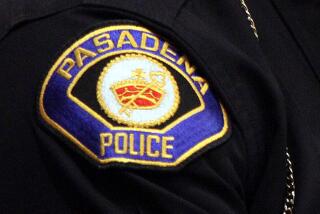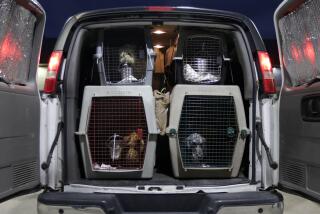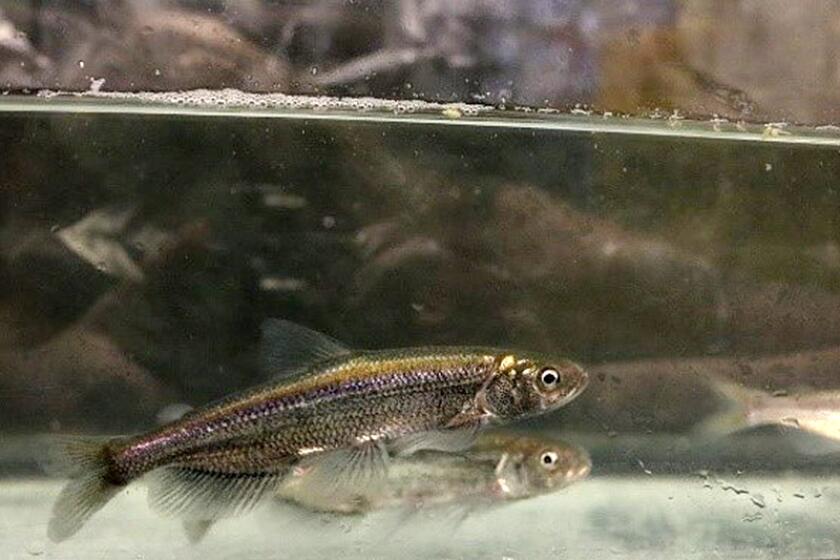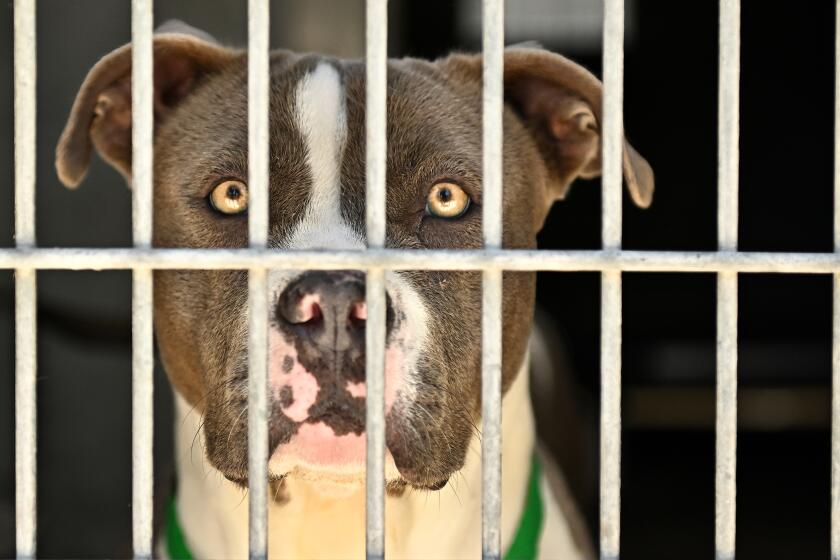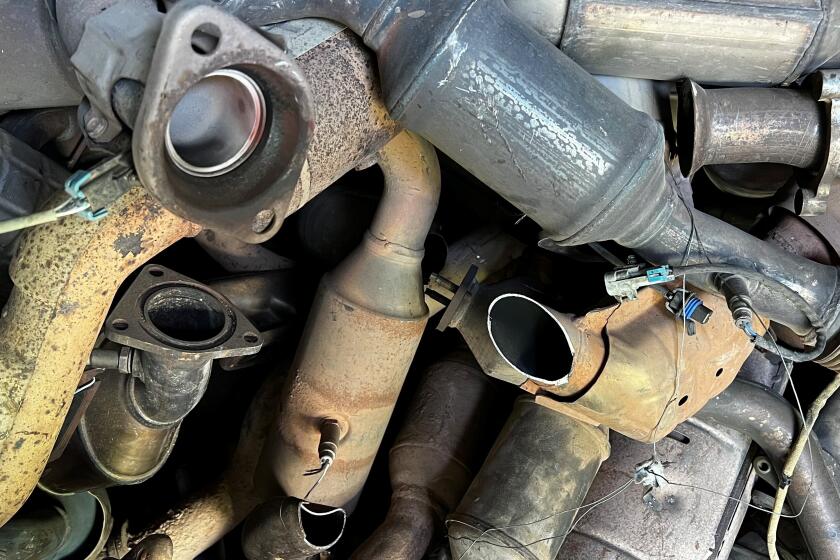Collaring a new breed of police dog
- Share via
Reporting from Jindo Island, South Korea — The puppies jostled for position, gnawing on one another’s tails and rolling in the grass of the outdoor pen. The two Los Angeles policemen watched them with the cool calculation they might give suspects in a crime lineup.
Officer Jeff Miller dangled a ball on a string to see if one of the seven dogs would bite — chase a would-be prey and pass the test.
“The white female,” he said to his partner, Sgt. Doug Roller, without taking his gaze from the animal. “That one likes the ball.”
The K-9 officers had come to Asia in search of a new breed of partner. Veteran dog trainers in the LAPD’s Metropolitan Division, they brought a combined 50 years’ experience in assessing animals that become a police officer’s most-trusted ally.
For years, the LAPD has relied mostly on such European bloodlines as German and Dutch shepherds and Belgian Malinois. But the handlers are conducting an experiment of sorts: gauging whether Jindo dogs native to this isolated island have the instincts for big-city police work — an often dangerous job that includes weapons detection and chasing down armed criminals.
Brought to Korea by invading Mongolian armies in the 13th century, the midsize Jindos are known for their intelligence and hunting skills. They’re so beloved here that they’ve been declared a cultural treasure.
Although breeders three years ago began promoting Jindos as potentially the newest generation of K-9 dog, even Korean police have yet to use them. During a July visit to the U.S., breeders offered four dogs free of charge to police departments in Los Angeles and Glendale, making arrangements to bypass a law that makes it difficult, and often illegal, to export purebred Jindos from South Korea.
If the partnership pans out, the two agencies would be the first in the world to use Jindos. Until this summer, neither Roller nor Miller knew anything about the dogs, but they quickly learned quirks of the breed that gave them pause.
Intensely loyal, the dogs can chafe if handled by more than one person. Topping out at about 60 pounds for males, they might lack the strength to subdue a 220-pound suspect, dog trainers say.
Owners add that the animals are prone to roam and even bolt, and are considered among the most difficult breeds to train. Many shy away from water.
Roller and Miller are considering a detection role for Jindos, but critics point to a fierce prey drive that could, for example, distract them from a bomb search if a mouse skitters by.
With a breeders association footing the bill, the pair used an all-expenses-paid trip last month to test a few of the 8,000 Jindos on the island for signs of the confidence, drive and chase instinct that makes for good patrol dogs.
“It takes a while to know if a dog has what it takes,” said Miller, 43, a two-decade department veteran.
The selection process involves plain dog sense — intangibles like knowing that puppies can be trained to become man-hunters, but that it’s tougher to teach an old dog new tricks.
On a blustery late autumn day, Miller shivered in the chill as he observed the rambunctious pups, working hard to resist the emotional tug of their antics. It’s a hard task.
“The thing about puppies,” he said as one dog growled in mock ferocity, “is that you can’t hold anything against them. They’re hard to test because at this age they don’t know anything.”
*
They have names Big Jake, Liberty, Friday and Tex.
The dogs, new K-9 officers soon learn, are to be considered like a gun or badge, what Roller calls “a tool to catch bad guys.”
But that’s not how it works out. Most K-9 officers are with their dogs around the clock. Relationships develop. “You get to know them and they get to know you even quicker,” Miller said.
Dogs sense when it’s time to work, recognizing the sound of a Velcro holster, a jangle of car keys. “I had one dog that went crazy, barking, twirling in its cage, when he knew we were leaving,” Miller said.
The best police dogs can be taught to enhance their chase instincts. Miller has even trained them to sniff out the oil-and-steel scent of hidden handguns.
Of the LAPD K-9 unit’s two dozen dogs, most work investigations, following the scent of suspects. Both Miller and Roller wear the unit’s insignia of a German shepherd holding a pair of handcuffs in its mouth above the warning “You can run, but you can’t hide.”
Dogs have been killed defending their partners. They’ve pulled suspects from freezers, ivy hedges, under car engine blocks, even cuddled up inside a doghouse — along with its pit bull resident.
“Dogs will point to spots, and you’ll think there’s no way anybody can be in there,” Roller said. “But their instincts take human logic out of the question. If they point to a concrete sidewalk, we’ll tear it up.”
Miller recently lost his 11-year-old Malinois, Benji, to old age. Roller, 53, a 28-year department veteran, also knows such loss. He still recalls the death of his first dog, Keno. “As a trainer, I give the speech about dogs being tools and not pets,” he said.
“But when Keno died, I cried like a baby. He was my buddy.”
*
The first Jindo tests were like a blind date, full of unknowns.
Over three days, the officers evaluated dogs of all sizes, most of the adults white and orange with pointy, upright ears and a raised, curly tail.
Miller passed Jindos in cages, puppies in pens. He rattled a tin of mints to catch their attention. Some ran. Others ignored him. A few pricked up their ears.
Assessing a clutch of pups, the team dismissed the alpha dog for less-aggressive choices. Breeders and reporters crowded around, watching the process, exciting the animals.
At one point, Roller took a white puppy off by himself, sitting in the grass with the dog on his lap. “I wanted to see if he’d come out of his shell,” he said. “He didn’t.”
The trainers conversed in the language of their craft. A dog that was “freaky” for a ball was a good thing. A “doggy” animal was not, meaning it had other things on its mind than chasing a tennis ball.
In the end, they chose four puppies that they brought back to Los Angeles for six months of initial training, two of which will go to Glendale police. Roller said he’s confident the animals will make good detection dogs. If not, they’ll either be put up for adoption or kept by the officers themselves.
Either way, Roller is hopeful he’s got a new partner among them. “I felt more comfortable doing this my way — taking a puppy over an older dog,” he said. “This way, it’s less of a roll of the dice.”
Ethan Kim of The Times’ Seoul Bureau contributed to this report.
More to Read
Sign up for Essential California
The most important California stories and recommendations in your inbox every morning.
You may occasionally receive promotional content from the Los Angeles Times.
